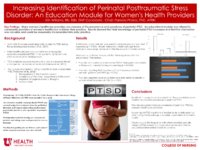The Graduate Nursing Project collection includes Doctor of Nursing Practice (DNP) Scholarly Projects and Master's students' non-thesis projects submitted as part of program requirements.
TO
- Graduate Nursing Project, Doctor of Nursing Practice, DNP15
- Graduate Nursing Project, Doctor of Nursing Practice, DNP, Women's Health / Nurse Midwifery, Poster2
- Graduate Nursing Project, Doctor of Nursing Practice, DNP, Neonatal, Poster1
- Graduate Nursing Project, Doctor of Nursing Practice, DNP, Primary Care FNP, Poster1
1 - 25 of 19
| Title | Creator | Date | Description | Relation Is Part Of | ||
|---|---|---|---|---|---|---|
| 1 |
 |
Panic-like Anxiety and Unexplained Chest Pain | Hermansen, Gary | 2018 | POSTER | Graduate Nursing Project, Doctor of Nursing Practice, DNP |
| 2 |
 |
Implementing Educational Training of the PHQ-2&9 in Primary Care Clinic | Nicol, Hanna | 2018 | POSTER | Graduate Nursing Project, Doctor of Nursing Practice, DNP |
| 3 |
 |
Establishing Routine Antenatal Depression Screening | Himes, Annette | 2018 | POSTER | Graduate Nursing Project, Doctor of Nursing Practice, DNP, Women's Health / Nurse Midwifery, Poster |
| 4 |
 |
Improving Pelvic Floor Dysfunction Screening in Primary Care | Hill, Alycia | 2018 | POSTER | Graduate Nursing Project, Doctor of Nursing Practice, DNP |
| 5 |
 |
Post-ICU PTSD Risk Screening Tool | Dayton, Kali | 2018 | POSTER | Graduate Nursing Project, Doctor of Nursing Practice, DNP |
| 6 |
 |
Evaluation of a Telehealth Intervention for Postpartum Depression | Wharton, Hollie J. | 2018 | POSTER | Graduate Nursing Project, Doctor of Nursing Practice, DNP |
| 7 |
 |
Increasing Identification of Perinatal Posttraumatic Stress Disorder: An Education Module for Women's Health Providers | Williams, Erin | 2018 | POSTER | Graduate Nursing Project, Doctor of Nursing Practice, DNP, Women's Health / Nurse Midwifery, Poster |
| 8 |
 |
A Clinical Practice Guideline for the Recognition, Diagnosis and Management of Neonatal Delirium | Schulte, Krista | 2018 | POSTER | Graduate Nursing Project, Doctor of Nursing Practice, DNP, Neonatal, Poster |
| 9 |
 |
Implementing VTE Screening in an Urgent Care Setting | Turgoose, William | 2018 | POSTER | Graduate Nursing Project, Doctor of Nursing Practice, DNP, Primary Care FNP, Poster |
| 10 |
 |
Improving Pelvic Floor Dysfunction Screening in Primary Care | Hill, Alycia | 2018 | Background: Dysfunction means that something is not working appropriately. The pelvic floor is composed of a network of muscles, ligaments, and tissues that act like a hammock to support the organs of the pelvis: the uterus, vagina, bladder, urethra, and rectum. If the muscles of these organs become... | Graduate Nursing Project, Doctor of Nursing Practice, DNP |
| 11 |
 |
Implementing Screening for Venous Thromboembolism in an Urgent Care Setting: A Quality Improvement Pilot Project | Turgoose, William | 2018 | Background: Venous thromboembolism (VTE), which includes both deep vein thrombosis and pulmonary embolism, may have serious health consequences for patients. However, over-referral of patients with these suspected symptoms may also result in burden to emergency departments and health care systems. E... | Graduate Nursing Project, Doctor of Nursing Practice, DNP |
| 12 |
 |
Assessing and Improving Health Care Provider's Knowledge and Treatment of Panic-like Anxiety and Unexplained Chest Pain in the Emergency Department | Hermansen, Gary | 2018 | This project assesses the knowledge and attitudes of health care providers (HCPs) in the emergency department (ED) of a 120-bed teaching hospital, regarding patients who present with unexplained chest pain (UCP), who may be suffering from panic-like anxiety (PLA). Several researchers have found that... | Graduate Nursing Project, Doctor of Nursing Practice, DNP |
| 13 |
 |
Evaluation of a Telehealth Intervention for Postpartum Depression | Wharton, Hollie J. | 2018 | Purpose. This project investigated the effectiveness of using a computer-based telehealth platform in order to facilitate early recognition and initiation of interventions for postpartum depression (PPD). The purpose of this project was to increase awareness and prevention of postnatal depression th... | Graduate Nursing Project, Doctor of Nursing Practice, DNP |
| 14 |
 |
Screening of Patients at Risk for Post-Intensive Care Unit Post-Traumatic Stress Disorder | Dayton, Kali | 2018 | Many patients discharged from the intensive care unit (ICU) setting experience post-ICU post-traumatic stress disorder (PTSD) for up to a year after discharge. With the right knowledge and screening tools ICU staff can minimize the frequency and severity of post-ICU PTSD. The focus of this project w... | Graduate Nursing Project, Doctor of Nursing Practice, DNP |
| 15 |
 |
A Clinical Practice Guideline for the Recognition, Diagnosis, and Management of Neonatal Delirium | Schulte, Krista | 2018 | Purpose. The objective of this project was to create a clinical practice guideline (CPG) in order to standardize the assessment and treatment of neonatal delirium in a newborn intensive care unit (NICU) environment. Methods. An evidence-based CPG was developed using literature pertaining to pediatri... | Graduate Nursing Project, Doctor of Nursing Practice, DNP |
| 16 |
 |
Increasing Awareness of Perinatal Posttraumatic Stress Disorder: An Education Module for Women's Health Providers | Williams, Erin | 2018 | Objective: The purpose of this project was to develop and evaluate an educational intervention to improve women's healthcare providers' knowledge of perinatal posttraumatic stress disorder (PTSD). Background: Approximately 16% of women meet diagnostic criteria for PTSD in the perinatal period. Pregn... | Graduate Nursing Project, Doctor of Nursing Practice, DNP |
| 17 |
 |
Establishing Routine Antenatal Depression Screening in a Medium-Sized Private Group Obstetric Practice | Himes, Annette | 2018 | Background. Antenatal depression is one of the most common complications of pregnancy (UMMHC, 2016). Studies have found prevalence rates anywhere from 14-23% in obstetric populations. Unfortunately, less than ten percent of American adults are appropriately screened for depression, and this statisti... | Graduate Nursing Project, Doctor of Nursing Practice, DNP |
| 18 |
 |
Barriers and Facilitators to Implementing One Key Question® in a Midwifery Practice within a University Health System | Labbe, Krista L. | 2018 | Prevention of unintended pregnancy and promotion of health prior to conception are widely accepted approaches to lowering maternal and infant mortality. Despite the likely substantial return on investment, routine screening for pregnancy intention is not typically incorporated into the care of repro... | Graduate Nursing Project, Doctor of Nursing Practice, DNP |
| 19 |
 |
Implementing Training Modules to Facilitate the Patient Health Questionnaire-2&9 (PHQ-2&9) Screening Administration for Improving Depression Screening in a Local Free Clinic | Nicol, Hanna | 2018 | Background: Major depressive disorder affects approximately 9 percent of the adult population annually and has a 17 percent lifetime prevalence in the United States (Maurer, 2012; Meyer & Grob, 2014; NIMH, 2015). Adult depression occurs more frequently in low income and uninsured populations in the ... | Graduate Nursing Project, Doctor of Nursing Practice, DNP |
1 - 25 of 19
